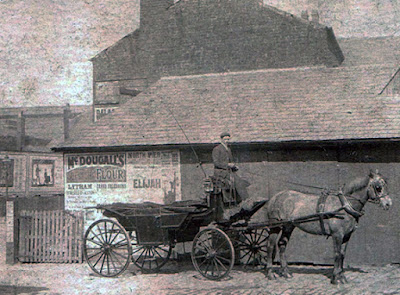Each week, Sepia Saturday, provides an opportunity for genealogy bloggers to share their family history through photographs.
Sepia Saturday's latest prompt photograph features a 1920s lorry. My mind turned immediately to my cousin's Oldham family of Blackpool, Lancashire, who were carters and coalmen down three generations. The business went from using horses to horsepower - and below is their first lorry purchased in 1921.
The
business was founded around 1890, by Joseph Prince
Oldham (1856-1921) and steadily became prosperous. In
1905 it moved to near North Station, Blackpool, Lancashire in a house with a large
yard, hay loft, tack room. and stabling for around 7 horses.
A
In the 1901 census Joseph Prince Oldham (below), son of William Oldham and Sarah Prince, was described as a self-employed carter and coal merchant. Also in the household
were Joseph's wife Mary Alice, his 20 year old son John William and three young daughters, Sarah Alice, Edith and
Beatrice, plus also mother-in-law Mary Ann Knowles.
The Oldham family c.1910 - Back: Sarah and John William Front: Father Joseph, Beatrice, Edith and mother Mary Alice.
Joseph Prince Oldham with his granddaughter Elsie
who later took over the business.
An accident at the coal sidings in the
railway station resulted in Joseph being blinded and he died in 1921,
with his will, signed with his "mark".
Son John William Oldham on one of the carriages
in the family business.
Joseph's son, John William Oldham (1880-1939)
Shortly before his death Joseph had purchased the first vehicle (at the top of this page) which was used alongside the horses and carts until the 1930's when
two new vehicles were bought.
 |
| Lorry c. 1936 |

This
vehicle was requisitioned during the Second World War by
Governmentfor use by the Fire Service. It was never returned.
John William Oldham married
Mary Jane Bailey (my grandfather's first cousin) in 1905 at St.
John's Church, Blackpool. The photograph below shows them standing,
with seated John's sister Sarah who went onto marry George Butler (front left) who also worked in the family business. Look at those hats!!

The couple faced tragedy with when their youngest daughter Hilda died aged 6 in 1915.
Family photograph c.1909 with baby Hilda
and older daughter Elsie.
On the death in 1939 of John William Oldham, his daughter Elsie (below)
took the helm with her husband Arthur Stuart Smith and saw the business through the difficult wartime
years, combining it with her own hairdressing concern as "Elise" run from the
family home.
 |
Elsie Oldham (1906-1989) - my mother's second cousin
| | | | | | |
|
The coal merchant business
was eventually sold around 1948 to another local firm, thus ending over
50 years of the family concern.
Elsie's daughter Gloria atop one of the last horses.
***************
Click HERE to read this week's blogs from other Sepia Saturday blogger.
*******************************




.jpg)











Ah, I do wonder why Americans have trucks while English have lorries! Great to see more family pics including the use of "lories" as well as horse and wagons.
ReplyDeleteWhat great horses! Such beautiful animals.
ReplyDeleteI love all the elegant photos.
Susan
It is interesting that the British term "lorry" didn't cross the 'pond' with British immigrants. I looked online to find out when the word 'truck' was first used & this is the explanation I fouond: The first known usage of "truck" was in 1611 when it referred to the small strong wheels on ships' cannon carriages, and comes from "Trokhos" (Greek) = "wheel". In its extended usage, it came to refer to carts for carrying heavy loads, a meaning known since 1771. It would have saved a friend of mine much embarrassment if we called trucks lorries as she had a 3 year old son who loved to excitedly point out trucks any time he saw one. Unfortunately, he had somehow picked up using an 'F' instead of a 'T' to say the word. Oops. :[]
ReplyDeleteThis was a super story to fit our truck/lorry theme. I really like the last photo of the little girl on the horse. I imagine many early trades and farms that used horses faced a difficult decision to convert to motor vehicles. Keeping a stable of workhorses created a human/animal bond that no machine could replace. And in the days of horsepower life kept a slower pace that sadly we can no longer appreciate in the 21st century.
ReplyDelete